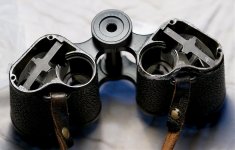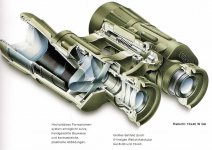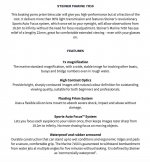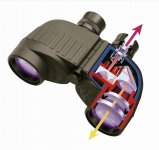John A Roberts
Well-known member

Hi Foss (post #14),
The Porro Steiners are an interesting case. In the higher grades they are at least optically adequate if not outstanding
However, in all grades they seem to have a common failing:
- they’re reasonably robust until they’re not
- and once not, often nothing can be done
There are a number of threads on this forum about such failures, including extensive first hand experience by Bill Cook
In terms of shock absorption, the largest mass glass components in binoculars are the prisms
And the choice for manufacturers is whether to:
- rigidly mount the prisms, and risk them chipping or cracking under transferred impact, or
- use a mount that allows some give
The traditional approach with Porros is to use a seat that gives rigid support on 5 sides but allows some give along the optical axis by the use of a spring retaining clip
see both the image of a Leitz Binuxit showing a slot in clip (from Tobias Mennle: http://www.greatestbinoculars.com/allpages/reviews/leica/binuxit/binuxit.html )
and that of Swarovski’s use of a clip with a retaining screw on one end
The Steiner design dates from the mid 1960’s, and was meant to be a lower cost alternative to traditional military binoculars by using innovative technology, combining:
- a rubber covered, polycarbonate (‘makrolon’) housing
- along with glued in place components, including the prisms
The problem with the Steiners is that the glue holds until it shears i.e. an all or nothing response - verses elastic give
The 8x30 version was adopted by the West German military as the Fero-D12, and used from around 1966 to 1972
However, it proved inadequate in service, which while including various routine duties and training activities - notably did not include the extremes of sustained war fighting
(and in Holger Merlitz’s comparative review of the D-12 and it’s contemporaries, it performs the weakest optically: http://www.holgermerlitz.de/zeiss8x30.html )
In contrast, I seem to remember (correctly?) Henry Link recounting that he once dropped a Swarovski Porro 10x40 from a short height onto carpet, causing one of the prisms to unseat
While in one sense an obvious failure, it was easily fixed when serviced
In recent catalogues Steiner refers to a ‘Floating Prism System’, see the attached screen grab. It seems to imply silicon padding (or perhaps just a more flexible silicon glue?) in the prism mount *
However, whether this significantly addresses the fundamental problem is unclear
Steiner Porros are widely used by armed forces e.g. the 2014 purchase of 15,000 units by the British: https://www.gov.uk/government/news/new-army-kit-helps-soldiers-see-more-clearly
However, modern military’s seem to increasingly treat binoculars as consumables, rather than gear to be maintained by skilled service technicians
In such circumstances the Steiner’s real strength in military use would be the unit price advantage
John
* there is a cross-section of a Steiner Military-Marine 7x50, however the mount details are unclear
The Porro Steiners are an interesting case. In the higher grades they are at least optically adequate if not outstanding
However, in all grades they seem to have a common failing:
- they’re reasonably robust until they’re not
- and once not, often nothing can be done
There are a number of threads on this forum about such failures, including extensive first hand experience by Bill Cook
In terms of shock absorption, the largest mass glass components in binoculars are the prisms
And the choice for manufacturers is whether to:
- rigidly mount the prisms, and risk them chipping or cracking under transferred impact, or
- use a mount that allows some give
The traditional approach with Porros is to use a seat that gives rigid support on 5 sides but allows some give along the optical axis by the use of a spring retaining clip
see both the image of a Leitz Binuxit showing a slot in clip (from Tobias Mennle: http://www.greatestbinoculars.com/allpages/reviews/leica/binuxit/binuxit.html )
and that of Swarovski’s use of a clip with a retaining screw on one end
The Steiner design dates from the mid 1960’s, and was meant to be a lower cost alternative to traditional military binoculars by using innovative technology, combining:
- a rubber covered, polycarbonate (‘makrolon’) housing
- along with glued in place components, including the prisms
The problem with the Steiners is that the glue holds until it shears i.e. an all or nothing response - verses elastic give
The 8x30 version was adopted by the West German military as the Fero-D12, and used from around 1966 to 1972
However, it proved inadequate in service, which while including various routine duties and training activities - notably did not include the extremes of sustained war fighting
(and in Holger Merlitz’s comparative review of the D-12 and it’s contemporaries, it performs the weakest optically: http://www.holgermerlitz.de/zeiss8x30.html )
In contrast, I seem to remember (correctly?) Henry Link recounting that he once dropped a Swarovski Porro 10x40 from a short height onto carpet, causing one of the prisms to unseat
While in one sense an obvious failure, it was easily fixed when serviced
In recent catalogues Steiner refers to a ‘Floating Prism System’, see the attached screen grab. It seems to imply silicon padding (or perhaps just a more flexible silicon glue?) in the prism mount *
However, whether this significantly addresses the fundamental problem is unclear
Steiner Porros are widely used by armed forces e.g. the 2014 purchase of 15,000 units by the British: https://www.gov.uk/government/news/new-army-kit-helps-soldiers-see-more-clearly
However, modern military’s seem to increasingly treat binoculars as consumables, rather than gear to be maintained by skilled service technicians
In such circumstances the Steiner’s real strength in military use would be the unit price advantage
John
* there is a cross-section of a Steiner Military-Marine 7x50, however the mount details are unclear
Attachments
Last edited:









